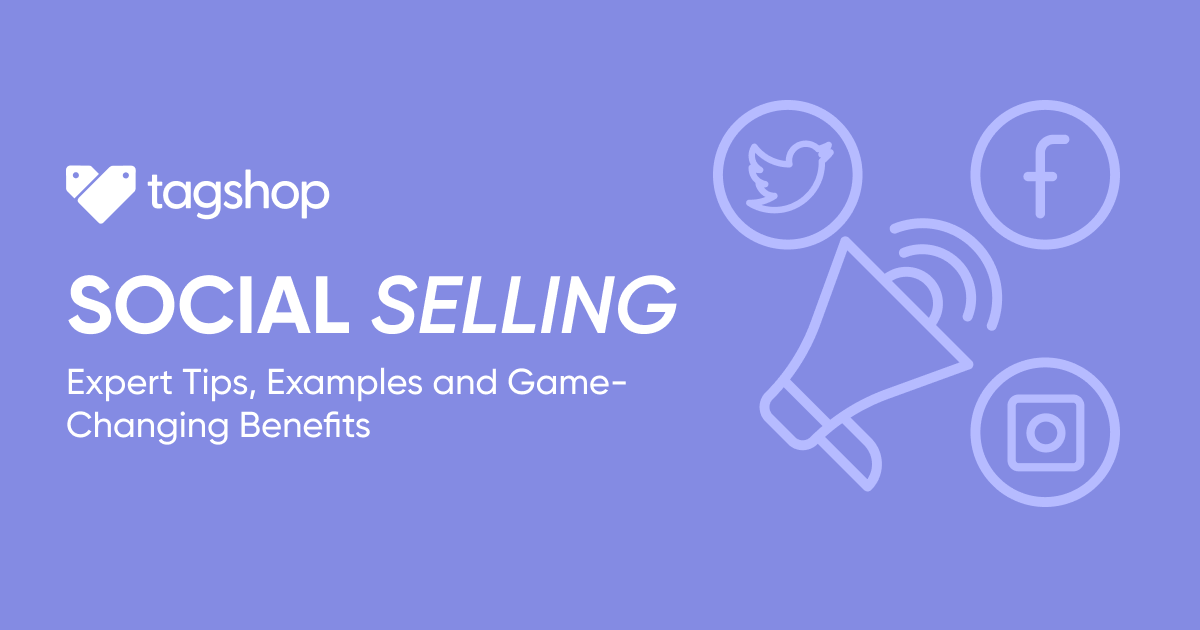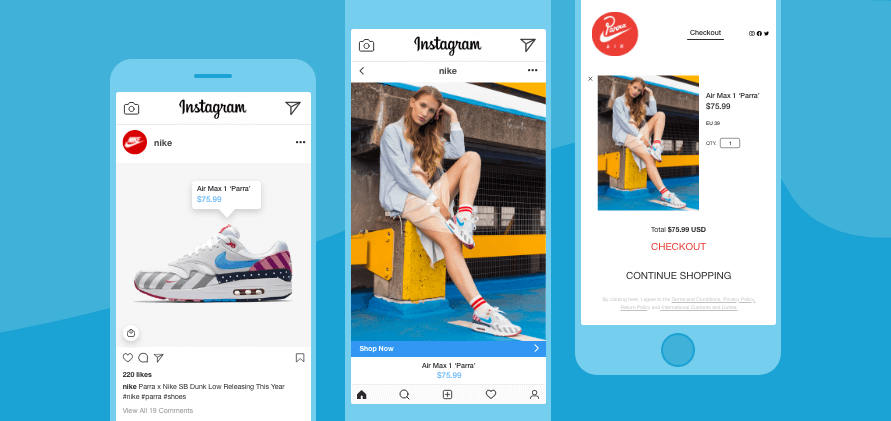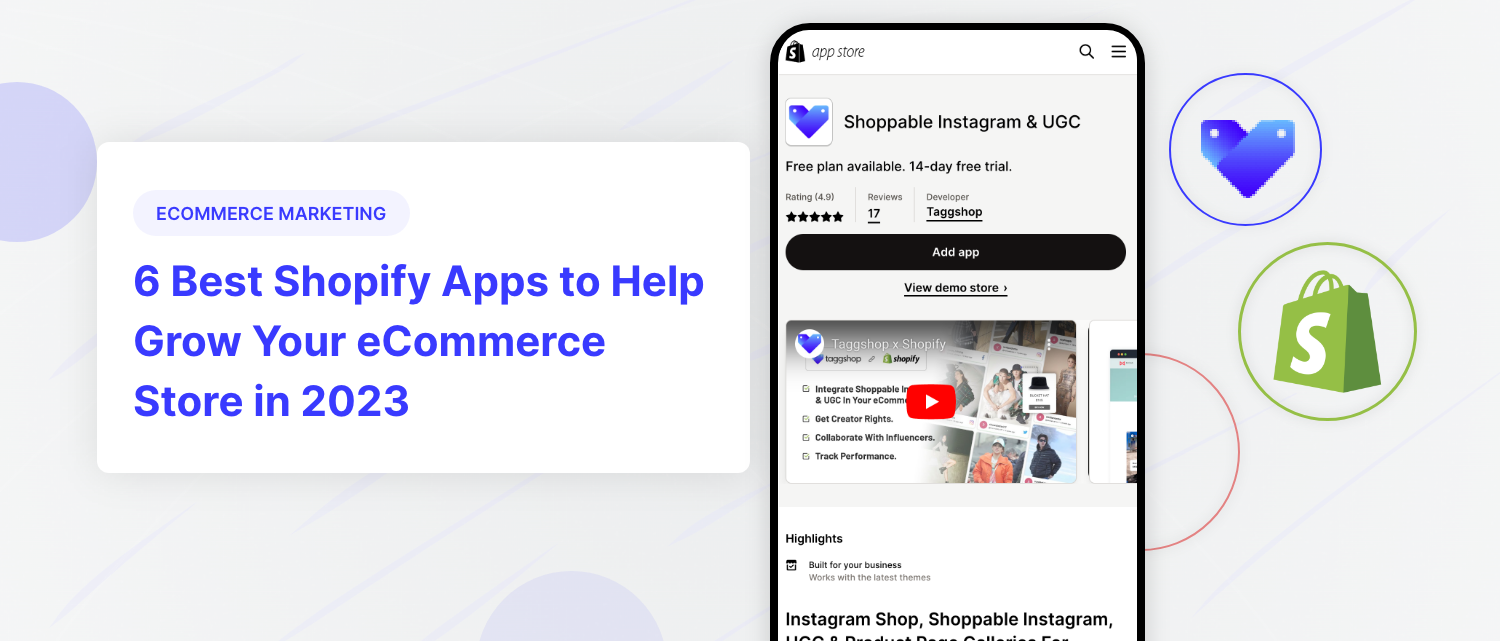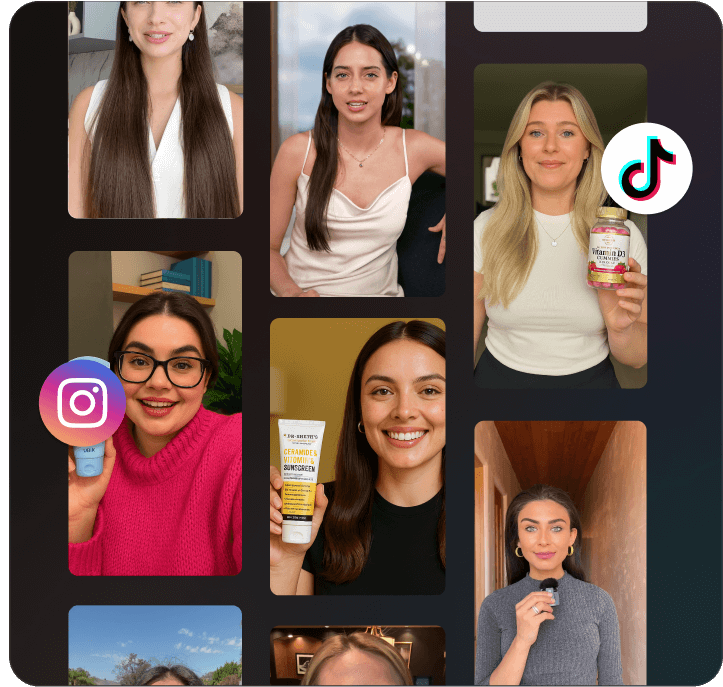Social Selling: Expert Tips, Examples, and Game-Changing Benefits
In today’s fast-paced digital age, selling has evolved beyond traditional techniques. Brands are moving along the lines of social media, and occurring from there is a new term – Social Selling. It is the new buzzword, and for all the right reasons.
In this blog, we will explore the meaning, importance, and benefits of this term. Whether you are a business owner or an e-commerce marketer, this blog will help you understand why it is critical to your success.
So, buckle up, and let’s dive into the chapters of social selling!
Definition of Social Selling
Social selling is the process of using social content to develop trust and awareness among potential customers, with the ultimate goal of converting them into actual buyers. It differs from traditional selling in several key ways.
It is often a more collaborative process where sellers work with marketing teams and tools in order to enable customers to shop for products from their e-commerce stores through embedded social content.
Social media plays a critical role in social selling. Social sellers can build stronger relationships, reach more prospects, and drive more sales by effectively leveraging social media content.
Benefits of Social Selling
Social media’s impact has revolutionized how people interact, develop relationships and make decisions. This technologically sound era has also given rise to various new social phenomena, such as social selling.

Researchers say 61% of organizations engaged in social selling report revenue growth.
And that’s not it. There is a multitude of benefits to including this phenomenon in your business strategy. Continue reading!
1. Enhanced personal branding and thought leadership
One of the key benefits of social selling is the opportunity to enhance personal branding and thought leadership.
Personal branding refers to establishing a unique and consistent image of oneself to others, which can be accomplished by leveraging carefully curated social content to its potential.
Statistically speaking, 78% of businesses that use social selling outperform those that don’t.
This increase in performance also allows businesses to establish themselves as leaders. By consistently utilizing visual social content, social sellers can present their brand principles and USPs to potential customers.
This helps build credibility and trust, which is essential for establishing and maintaining relationships with potential customers.
2. Higher conversion rates and revenue growth
Establishing a significant presence on social media platforms is not all. There is another blend of powerful potions that can more prominently lead to higher conversion rates and revenue growth.
The combination of social selling and UGC. UGC is a trusted source of social proof of a brand’s quality and value. By including UGC, social sellers can better understand what customers like and dislike about a product or service and use that information to tailor their product galleries and offerings to meet customer needs better.
Sales professionals who use social selling close 40-50% more new business than those who don’t.
By leveraging UGC effectively, social sellers can build stronger customer relationships, increase sales, and drive business growth.

3. Improved customer engagement and relationship-building
It can contribute to improved customer engagement and relationship-building. As stated above, user-generated content is crucial for reaching the best potential of social selling.
Social sellers can demonstrate their commitment to customer service and build rapport with potential customers by responding to comments and messages and showcasing user-created shoppable content on their eCommerce stores.
Visitors spend 90% more time on websites that include UGC galleries.
Social sellers can build a loyal following and foster a sense of brand affinity by sharing content and engaging with customers more directly.
4. Increased Brand Visibility & Awareness
Social selling can significantly increase a brand’s visibility and awareness among its target audience. By leveraging social content – be it UGC or branded content, sales professionals can reach out to prospects and engage with them through relevant and personalized content.
Additionally, it offers sales professionals opportunities to share content promoting the brand and its products/services to a more varied audience.
77% of shoppers are likelier to buy a product they found through UGC.
This, in turn, leads to more sales and awareness for the brand as it gains exposure to a wider audience.

Tips & Best Practices to Implement Social Selling
Implementing social selling strategies can be a game-changer for businesses, but it requires more effective strategies and an understanding of the e-commerce sphere.
Statistically speaking, businesses prioritizing social selling are 51% more likely to reach their sales quota.
Here are some tips for eCommerce marketers to implement it:
1. Use Analytics To measure Success:
Using analytics to measure success is a critical best practice when implementing social selling strategies.
Analytics tools can help sales teams track and measure their eCommerce activities’ impact, identify improvement areas, and optimize their strategies for maximum impact. Additionally, solid internal communications ensure that insights and strategies are effectively shared and implemented across the team.
This information can also help brands understand which social media platforms are most effective for engaging potential customers, which types of content drive engagement, and which strategies are most effective for generating leads and closing sales.
2. Share Authentic Content:
Buyers today are looking for unbiased and genuine connections with brands, and sharing authentic content can help to establish trust and build relationships with potential customers.
Sharing relevant and valuable content to their target audience can instantly amp up any business’s authenticity. It can speak of your brand’s principles and values and even help you boost brand awareness and visibility.
By sharing authenticity, you can collect more user-generated content from your existing audience and utilize it to create shoppable galleries and build a stronger social selling strategy.

3. Stay Up-to-date
It relies heavily on content creation and distribution, and it i’s essential to provide your audience with valuable and relevant information that keeps them engaged and interested in your brand.
One way to keep your content fresh is by regularly researching your target audience and industry trends. This will help you create content that resonates with your audience and speaks to their pain points and challenges.
Another way to keep your content up-to-date is by leveraging various types of content, such as branded content, influencer content, and user-generated content. This can help you reach a wider audience and keep your content engaging and shareable.
Lastly, reviewing and updating your content regularly is important to ensure it remains relevant and valuable. Analyze your metrics and user feedback to identify which types of content resonate most with your audience and adapt your strategy accordingly. Keeping your content fresh and up-to-date can improve your social selling efforts and increase your chances of success.
4. Foster Meaningful Collaborations
Fostering meaningful collaborations is an essential practice when implementing social selling.
It is all about building relationships with customers, prospects, and industry influencers through social media channels. Collaborations with these groups can help you expand your reach, gain credibility, and establish yourself as a thought leader in your industry.
To foster meaningful collaborations, identify the individuals or organizations that align with your brand values and can provide value to your target audience. If you need help discovering and managing great partners, consider developing an effective influencer marketing strategy, as explained in the Influencer Marketing Expert Guide. By building and nurturing these relationships, you can create a network of supporters who can help amplify your brand message and drive sales.
5. Develop A Social Selling Inclusive Sales Strategy
Developing a sales strategy inclusive of social selling is essential to achieve best results most effectively. To develop this strategy, you must first understand your target audience and their behavior on social media platforms and towards different formats of social content.
This way, you can find out what your audience is reacting towards the most, and you can include those practices in your sales strategy. Such as, you can create a social media content plan that aligns with your overall sales strategy.
This plan should include relevant and engaging content that appeals to your target audience and showcases your brand’s products or services.
It is essential to know how to keep your audiences engaged in the ever-changing nature of social media and to keep a check on the effectiveness of an eCommer marketer is using social media for sales.
This is when the Social Selling Index comes into play. Continue reading to know more about it.
Difference between Traditional Selling and Social Selling

The key difference between the terms is the approach and methodology used to reach and engage potential customers.
- Traditional selling typically involves a more transactional approach, where salespeople focus on closing a sale by presenting a product or service’s features and benefits to a potential customer. This approach often relies on cold calls, cold email marketing, and face-to-face meetings to reach potential customers.
- On the other hand, social selling focuses on building relationships with potential customers through social media content. Rather than simply pitching a product or service, it involves sharing valuable content, engaging in conversations, and building trust and credibility with potential customers.
- Social selling also involves leveraging data and insights of the shoppable social content to better understand the needs and preferences of potential customers. This data extraction allows marketers to tailor their approach and messaging to better meet the needs of their target audience.
- Another key difference between traditional selling and social selling is the role of technology. It relies heavily on social media platforms and tools, such as social commerce tools, social listening, and analytics software, to track engagement.
- While they share some similarities, such as the ultimate goal of driving sales, social selling takes a more relationship-driven and data-focused approach to reaching and engaging with potential customers.

What is the Social Selling Index?
The Social Selling Index (SSI) is a valuable tool for measuring the efficiency of social selling in your sales strategy.
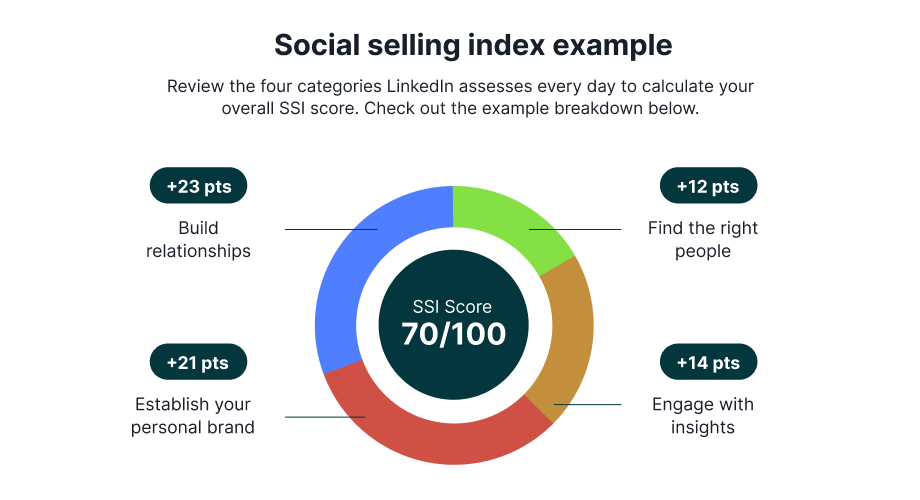
The SSI score can provide insight into the effectiveness of your social selling efforts by measuring your performance in four key areas: establishing your professional brand, finding the right people, engaging with insights, and building relationships.
By evaluating your SSI score regularly, you can identify areas where you need to improve your efforts.
The SSI is important for several reasons:
1. Measures effectiveness:
The SSI measures an eCommerce marketer’s effectiveness in using social media for sales. It evaluates four essential areas for its success: establishing a professional brand, finding the right people, engaging with insights, and building relationships. By measuring these areas, the SSI clearly shows how well a marketer is leveraging social media to drive sales.
2. Identifies strengths and weaknesses:
The SSI score provides insights into a marketer’s strengths and weaknesses in social selling. This information can be used to identify areas where an eCommerce marketer needs to improve their performance, such as creating more engaging content or building stronger relationships with potential customers. Incorporating performance testing helps further evaluate how effectively these improvements impact key metrics, ensuring that the strategies adopted lead to tangible results in social selling efforts.
3. Benchmarks performance:
The SSI score can benchmark an eCommerce marketer’s performance against industry standards and peers. This information can help salespeople understand how they compare to their competitors and identify areas where they need to improve to stay competitive.
4. Enables data-driven decision making:
The SSI score provides a data-driven approach to social selling. eCommerce marketers and organizations can use the SSI score to evaluate the effectiveness of their overall efforts and make data-driven decisions on training, coaching, and resource allocation within their coaching sales funnel.
After Knowing Your SSI Score, What’s Next?
Once you have measured your brand’s SSI score, you can use it to help your brand in several ways.
- By leveraging your score and continuing to engage with your network, you can build a strong social media presence that supports your overall brand strategy.
- A high SSI score indicates that you have a strong presence on social media and are actively engaging with your network. Your SSI score can also help you generate leads by providing insights into your selling activities.
- By analyzing your SSI score, you can identify areas where you need to improve and develop a strategy for reaching out to potential customers.
- A strong Social Selling Index score can help you establish credibility and monitor and measure your social selling performance.
Here are a few compelling brand examples actively including it in their sales strategy and working toward the top.
Social Selling Examples
1. Malandra:

Malandra is a fashion brand that focuses on handmade jewelry and accessories. The company has quickly become known for its unique and stylish designs. Malandra operates primarily through social media platforms such as Instagram, with over 150k followers. The brand has also established partnerships with influencers and bloggers, who help to promote its products and reach a wider audience.
Malandra uses social selling strategies to engage with its customers and create a sense of community around its brand. For example, the company often shares user-generated content on its Instagram page, featuring customers wearing its products and sharing their personal stories. Malandra then uses this content to boost website traffic and drive sales by turning social content into shoppable content.
2. Stella & Dot:

Stella & Dot is a direct sales company specializing in jewelry and accessories. Founded in 2004, the company has a network of over 50,000 independent stylists who sell its products through it. Stella & Dot uses powerful social content and adds it to product pages on their website to drive sales.
Stella & Dot’s social selling model is based on building personal relationships and providing a personalized shopping experience. The brand offers one-on-one consultations and helps customers select products that fit their style and preferences. The company also showcases authentic user-generated content to create a sense of customer inclusivity.
3. Cluse:

Cluse is a watch and jewelry brand that was founded in 2013. The company’s products are minimalist and stylish, focusing on affordable luxury. Cluse primarily sells its products through its website and social media platforms such as Instagram, where it has over 500k followers.
Cluse’s social selling strategy is based on creating a strong visual identity and engaging with its audience through powerful visual content. The company’s Instagram page features high-quality product photos and lifestyle images, creating a cohesive and aspirational brand image. Cluse also collaborates with influencers and bloggers, who help to promote its products and reach a wider audience.
4. Rodan + Fields:
Rodan + Fields is an American multi-level marketing company specializing in skincare products. The company’s products are sold through a network of over 300,000 independent consultants, who use socially inclusive sales strategies to promote and sell the brand.
The brand is tapping the potential of well-curated UGC by showcasing it on its eCommerce store in different formats, such as images and comprehensive product videos. The brand has turned this content shoppable as a part of its social selling strategy.
The brand has refined its social selling strategy, gained revenue, and increased website traffic.

Conclusion
In conclusion, social selling has become crucial to modern marketing and sales strategies. By leveraging social content, businesses can build stronger relationships with their target audience, increase brand awareness, and drive more sales.
eCommerce marketers are expanding their horizons and welcoming new methods to examine their put-together strategies. Measuring metrics like Social Selling Index to measure the effectiveness of social selling and other social commerce tools to make their process smoother are now coming in force.
In addition to using the SSI, businesses can also incorporate user-generated content (UGC) into their strategies to build trust and credibility with prospects. UGC can also provide valuable insights into customer preferences and behaviors, helping businesses tailor their marketing strategy to meet their target audience’s needs better.
Social selling offers numerous benefits for businesses, including increased brand awareness, stronger customer relationships, and higher sales conversions. By following best practices and incorporating tools like the SSI and UGC into their strategies, businesses can effectively engage with prospects and build long-term, valuable relationships.
FAQs
Yes, it has the potential to grow your business and increase sales. By leveraging social media content, businesses can reach a wider audience, build stronger relationships with potential customers, and drive more sales.
Social selling requires a strategic approach and a commitment to building relationships with your target audience. By incorporating it into your marketing and sales strategies and leveraging tools such as the Social Selling Index and user-generated content, you can effectively engage with prospects and build long-term, valuable relationships that can drive growth for your business.
